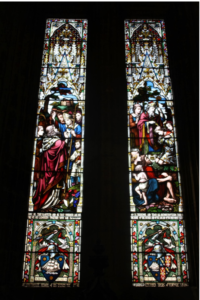
Stained Glass in Glasgow Cathedral, dedicated to the memory of Alexander Spiers.
Two stained glass windows in the sacristy of Glasgow Cathedral are dedicated to the memory of Alexander Spiers of Elderslie (1714-82).
Born in Edinburgh, Spiers was first a plantation owner and enslaver in Virginia, before relocating to Glasgow in the 1740s to develop a number of partnerships in the city, later becoming becoming town treasurer in 1750s, and Town Bailie twice in the 1750s and ‘60s.
In addition to an investment in the Wester Sugar House, situated on the corner of Candleriggs and Bells Wynd, Alexander Spiers amassed a substantive fortune through investment in a number of industries which profited from involvement with the transatlantic slave economy – such as tobacco, rum, and ironworks, and the associated banking industries that grew from these.
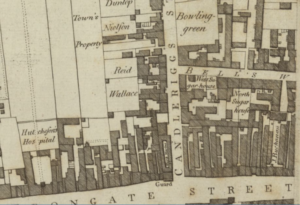
Section of map showing Wester Sugar House, situated on the corner of Candlerigg and Bells Wynd.
In 1770 Spiers inherited Virginia Mansion, located on Canon Lane (later Ingram Street) in Glasgow. Virginia Mansion was owned by the Buchanan family (whom Speirs married into), and it was based on the design of Colen Campbell’s Shawfield House, located opposite the north entrance to Glassford Street.
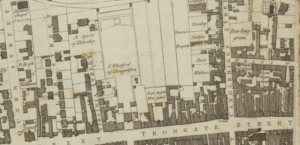
A. Speirs of Eldersley’s Virginia Mansion, adjacent to the site of J. Glasford of Douglaston’s property. Shawfield Mansion is located at the south end of the Glassford site.
Shawfield House was Colen Campbell’s first known design, and was featured in Campbell’s 3-volume publication of his architectural designs, titled Vitruvius Britannicus, which popularised the Palladian architectural style through the 18th century.
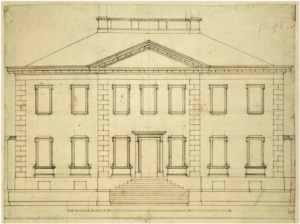
Colen Campbell’s Shawfield House, built 1712.
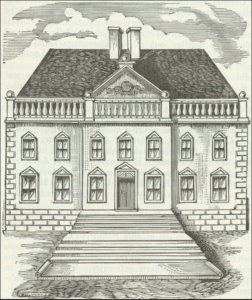
Virginia Mansion, Canon Lane (demolished mid 19th century)
Virginia Mansion was therefore one of the most significant and fashionable town houses in Glasgow during the 18th century, and demonstrates the considerable wealth, status and influence that Speirs held within the city through his involvement with the city’s links to transatlantic slave economy.
Later that decade, Speirs also commissioned the development of Kings Inch, later Elderslie House, near Renfrew.
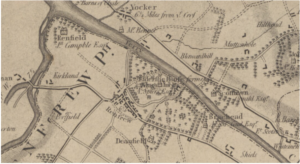
1795 map, showing Elderslie House estate in Renfrew, adjacent to the river.
This is located where the Brahead shopping centre now stands. Original plans were designed by once of the most famous Architects of his time – Robert Adam in 1776, but it was Robert Robinson who was engaged to construct this building in 1777.

Elderslie House, built by Robert Robinson, 1777-82.
Information taken from: Vitruvius Britannicus, 1717, the National Library of Scotland Map library the Dictionary of Scottish Architects, Old Country Houses of the Old Glasgow Gentry, 1878, and the RIBA archives.
Image Attribution:
Image 1:- Stained Glass in Glasgow Cathedral, dedicated to the memory of Alexander Spiers. (Creative Commons)
Image 2:- Plan of the City of Glasgow: Gorbells and Caltoun / from an actual survey by John McArthur … Engraved by Alexr. Baillie and James Lumsden, etc. North-west, 1778. (https://maps.nls.uk/view/102190567)
Image 3: –Plan of the City of Glasgow: Gorbells and Caltoun / from an actual survey by John McArthur … Engraved by Alexr. Baillie and James Lumsden, etc. North-west, 1778. (https://maps.nls.uk/view/102190567)
Image 4:- Colen Campbell’s Shawfield House, built 1712. Vitruvius Britannicus, London, 1717, Vol.II, Plate 51. (www.RIBApix.)
Image 5: – Virginia Mansion, Canon Lane (demolished mid 19th century) (Mitchell Library, Glasgow )
Image 6: – Map of the town of Glasgow & Country Seven Miles Round, from actual survey / by Tho. Richardson … (Kirkwood sculpt.). 1795. S(https://maps.nls.uk/towns/rec/7497)
Image 7: – Elderslie House, built by Robert Robinson, 1777-82. (Old Country Houses of the Old Glasgow Gentry, 1878)